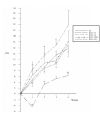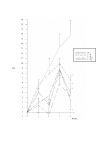The antihyperlipidemic activities of 4(3H) quinazolinone and two halogenated derivatives in rats
- PMID: 16202158
- PMCID: PMC1266394
- DOI: 10.1186/1476-511X-4-22
The antihyperlipidemic activities of 4(3H) quinazolinone and two halogenated derivatives in rats
Abstract
In the present study, the effects of subchronic treatments (4 weeks) of hypercholesterolemic (single) and diabetic-hypercholesterolemic (combined) rats with 4 (3H) quinazolinone and 2 halogenated derivatives (6, 8-dibromo-2-methy-4 (3H) quinazolinone and 6-iodo-2-methyl-4(3H) quinazolinone) at a sublethal dose level (2 mg/Kg) on cholesterol metabolism were investigated. Bezafibrate, a hypolipidemic drug was used as a reference compound for data comparison. Treatment of rats with single and combined hypercholesterolemia with quinazolinone compounds gave rise to highly significant reductions in serum total cholesterol and cholesterol ester levels, whereas serum triacylglycerol level was significantly reduced only after treatment with halogen-substituted quinazolinones in single hyper-cholesterolemia, compared to the control group. The effects of different quinazolinones and bezafibrate on reduction of serum LDL-C level were comparable in single hypercholesterolemia but significantly different in combined hypercholesterolemia. Results obtained from this study suggest that the antihyperlipidemic effect of quinazolinone compounds was brought about by inhibition of dietary cholesterol absorption and / or intestinal ACAT activity.
Figures


Similar articles
-
Study of the hypolipidemic properties of pectin, garlic and ginseng in hypercholesterolemic rabbits.Pharmacol Res. 1999 Feb;39(2):157-66. doi: 10.1006/phrs.1998.0421. Pharmacol Res. 1999. PMID: 10072708
-
Synthesis and hypolipidemic activities of novel 2-[4-[diethoxyphosphoryl)methyl]phenyl]quinazolines and 4(3H)-quinazolinones.J Med Chem. 1996 Mar 29;39(7):1433-7. doi: 10.1021/jm9506938. J Med Chem. 1996. PMID: 8691473
-
Antihyperlipidemic effect of D-pinitol on streptozotocin-induced diabetic Wistar rats.J Biochem Mol Toxicol. 2008 Jul-Aug;22(4):220-4. doi: 10.1002/jbt.20218. J Biochem Mol Toxicol. 2008. PMID: 18752266
-
Pharmaceutical prospects of naturally occurring quinazolinone and its derivatives.Fitoterapia. 2017 Jun;119:136-149. doi: 10.1016/j.fitote.2017.05.001. Epub 2017 May 8. Fitoterapia. 2017. PMID: 28495308 Review.
-
Quinazoline and quinazolinone as important medicinal scaffolds: a comparative patent review (2011-2016).Expert Opin Ther Pat. 2018 Apr;28(4):281-297. doi: 10.1080/13543776.2018.1432596. Epub 2018 Feb 5. Expert Opin Ther Pat. 2018. PMID: 29368977 Review.
Cited by
-
Synthesis and cytotoxic evaluation of some new 3-(2-(2-phenylthiazol-4-yl) ethyl)-quinazolin-4(3H) one derivatives with potential anticancer effects.Res Pharm Sci. 2017 Aug;12(4):290-298. doi: 10.4103/1735-5362.212046. Res Pharm Sci. 2017. PMID: 28855940 Free PMC article.
-
Experimental and Clinical Pharmacology of Andrographis paniculata and Its Major Bioactive Phytoconstituent Andrographolide.Evid Based Complement Alternat Med. 2013;2013:846740. doi: 10.1155/2013/846740. Epub 2013 Mar 24. Evid Based Complement Alternat Med. 2013. PMID: 23634174 Free PMC article.
-
N-(2-Aminobenzoyl)benzotriazole Mediated Synthesis of 3-Acyl-2-alkyl(aryl)-4-hydroxyquinolines and 3-Acylamino-4(3H) quinazolinones.Turk J Chem. 2023 Oct 16;48(1):97-107. doi: 10.55730/1300-0527.3642. eCollection 2024. Turk J Chem. 2023. PMID: 38544903 Free PMC article.
-
Antioxidant, Cytotoxic, Genotoxic, and DNA-Protective Potential of 2,3-Substituted Quinazolinones: Structure-Activity Relationship Study.Int J Mol Sci. 2021 Jan 9;22(2):610. doi: 10.3390/ijms22020610. Int J Mol Sci. 2021. PMID: 33435390 Free PMC article.
-
Synthesis, Structural Studies, and α-Glucosidase Inhibitory, Antidiabetic, and Antioxidant Activities of 2,3-Dihydroquinazolin-4(1H)-ones Derived from Pyrazol-4-carbaldehyde and Anilines.ACS Omega. 2019 Oct 25;4(19):18087-18099. doi: 10.1021/acsomega.9b01906. eCollection 2019 Nov 5. ACS Omega. 2019. PMID: 31720511 Free PMC article.
References
-
- Habib NS, Ismail KA, El-Tombary AA, Abd El-Aziem T. Antilipidemic agents, Part IV: Synthesis and antilipidemic testing of some heterocyclic derivatives of hexadecyl and cyclohexyl hemisuccinate esters. Pharmazie. 2000;55:495–499. - PubMed
-
- Fuster V, Alexander PW, O'Rourke RA, Roberts R, King SB, Wellens HJ. Hurst's the heart. 10. Vol. 3. New York, Mc Graw-Hill; 2001. Atherogenesis and its determinants; p. 1065.
-
- Devlin T. Textbook of biochemistry with clinical correlations. 3. New York, Wiley-Liss Inc; 1995. pp. 376–381.
-
- McNamara DJ. Dietary cholesterol and atherosclerosis. Biochim Biophys Acta. 2000;1529:310–320. - PubMed
MeSH terms
Substances
LinkOut - more resources
Full Text Sources
Medical

